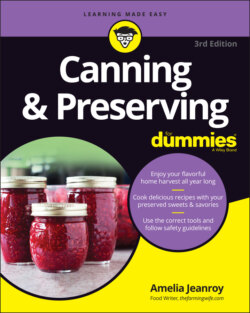Читать книгу Canning & Preserving For Dummies - Amelia Jeanroy - Страница 16
Approved methods
ОглавлениеAlthough you may hear of many canning methods, only two are approved by the United States Department of Agriculture (USDA). These are water-bath canning and pressure canning.
Water-bath canning: This method, sometimes referred to as hot water canning, uses a large kettle of boiling water. Filled jars are submerged in the water and heated to an internal temperature of 212 degrees for a specific period of time. Use this method for processing high-acid foods, such as fruit, as well as items made from fruit, pickles, pickled food, and tomatoes. Chapter 4 explains this method in detail.
Pressure canning: Pressure canning uses a large kettle that produces steam in a locked compartment. The filled jars in the kettle reach an internal temperature of 240 degrees under a specific pressure (stated in pounds) that’s measured with a dial gauge or weighted gauge on the pressure-canner cover. You use a pressure canner for processing vegetables and other low-acid foods, such as meat, poultry, and fish. For more information about pressure canning, see Chapter 9. Don’t confuse a pressure canner with either a pressure cooker or an electric multi-cooker that includes a Canning button, both of which are used to cook food quickly. A pressure cooker does not have adequate room for both the canning jars and the water needed to create the right amount of pressure to preserve foods. At one time, manufacturers of some consumer pressure cookers stated that they were safe for pressure canning; however, they have since issued a correction and acknowledged that their pressure cookers cannot be used safely for pressure canning.
In both water-bath canning and pressure canning, you heat your filled jars of food to a high temperature in order to destroy microorganisms and produce an airtight vacuum seal. The only way to reliably produce a safe canned product is to use the correct method for your type of food, follow your recipe instructions to the letter, and complete each processing step. For all the details you need about canning and a plethora of recipes, head to Parts 2 and 3.
